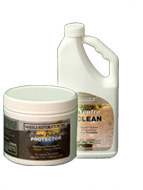Grout Care Guide
Question: How do I clean my dirty grout?
Grout care questions and answers for ceramic, porcelain, and granite, tiles; (marble and limestone tiles will be discussed in a subsequent section). This section will discuss grout care on floors, walls, and countertops.
How to Clean Grout
Answer: Most of our customers tell us, they have tried many store-bought grout cleaners over the years, and none of them seem to work. The vast majority of grout that is used today and over the years is made from cementitious material, which is strong, durable, but extremely porous. Improper cleaning, infrequent cleaning, food and beverage spills, animal (pet) accidents, age (air pollutants combined with humidity) will all discolor grout.
Our Grout Restoration Kit contains everything you will need to clean, restore, and seal your old, discolored grout to a brand new condition; and keep it looking new for many years to come. The first step prior to cleaning (restoring) your grout, is to watch our Instructional How To Do It DVD. If your project happens to be a kitchen, bathroom, laundry room, family room, or mud room floor; then, you might want to use our Stand-Up Grout Cleaning System, which eliminates the need to bend over, or get down on hands and knees, your able to clean large areas of the floor without getting tired.

Please Note: Additional Grout Cleaning Brushes, Cleaner and Sealer Applicators, Large Grout Sponges, Grease and Grime Buster, all can be purchased on our Website in the Accessories category. Additional Grout Guard Restorer and Grout Guard Protector can also be purchased on our Website, in the Grout Cleaner/Restorer and Grout Sealer categories, respectively.
Before you start the cleaning process, you want to prep the work area: adjacent areas not containing grout to be cleaned, such as, carpet, hardwood floors, baseboards, cabinets, appliances, painted walls, wall papered walls, thresholds and door jams, glass, metal, polished marble; all need to be protected and covered with plastic sheeting applied with duct tape, (use painters tape) where you think the duct tape adhesive residue could be problematic.
Please Note: Adhesive residue from duct tape is easily removed by using a paper towel and a small amount of lacquer thinner, or acetone (also contained in nail polish remover). Do not use lacquer thinner, or acetone on painted areas or on polyurethane which is typically on hardwood floors; use instead, a small amount of our Marble Polish and Protector or our Granite Polish and Protector, applied with a paper towel; both of these products will remove adhesive residue from duct tape without damaging paint or polyurethane.
Grout Cleaning On Floors, Walls, And Countertops
How to Clean Grout on Floors, Walls, and Countertops
For light to medium dirty, discolored, grout: apply Grout Guard Restorer to approximately three lineal feet of grout, work with a grout brush for about twenty seconds, pick-up this dirty solution with a damp sponge or mop, and rinse this area two times with clean water, before continuing this same process on the next three lineal feet of grout, repeat this process until the entire area is finished. Please Note: always rinse with clean water, do not reintroduce dirty water onto grout that has been cleaned and not sealed with our Grout Guard Protector. Sealing grout will be discussed later in this guide.
For medium to very dirty, discolored, grout: make a grout cleaning paste by mixing our Grease and Grime Buster with our Grout Guard Restorer to a consistency of cookie/pancake batter, next, apply Grout Guard Restorer to approximately three lineal feet of grout, apply the grout cleaning paste over this area, work with a grout brush for about twenty seconds, pick-up this dirty solution with a damp sponge or mop, and rinse this area two times with clean water, before continuing this same process on the next three lineal feet of grout, repeat this process until the entire area is finished. For extremely dirty, discolored grout, it might be necessary to repeat this grout cleaning process. In rare cases, the grout might be permanently discolored and the only remedy is to remove and replace with new grout.
Question: How do I clean my dirty grout on marble and limestone floors, walls, and countertops?
Answer: There is no better grout cleaner for ceramic, porcelain, and other man-made tiles than our Grout Guard Restorer; however, it contains 10% phosphoric acid in its formulation, which will etch marble and limestone. Therefore, when cleaning grout on marble and limestone floors, walls, and countertops use our fabulous Grout Guard Restorer for Marble.
Before you start the cleaning process, you want to prep the work area: adjacent areas not containing grout to be cleaned, such as, carpet, hardwood floors, baseboards, cabinets, appliances, painted walls, wall papered walls, thresholds and door jams, glass, metal, polished marble; all need to be protected and covered with plastic sheeting applied with duct tape, (use painters tape) where you think the duct tape adhesive residue could be problematic.

Please Note: Adhesive residue from duct tape is easily removed by using a paper towel and a small amount of lacquer thinner, or acetone (also contained in nail polish remover). Do not use lacquer thinner, or acetone on painted areas or on polyurethane which is typically on hardwood floors; use instead, a small amount of our Marble Polish and Protector or our Granite Polish and Protector, applied with a paper towel; both of these products will remove adhesive residue from duct tape without damaging paint or polyurethane.
Directions: *Shake bottle well and often during the entire cleaning process* Apply Grout Guard Restorer for Marble undiluted liberally to approximately three lineal feet of grout, work with a non-metallic grout brush for about twenty seconds, pick-up this dirty solution with a damp sponge or mop, and rinse this area two times with clean water, before continuing. When finished, be sure to apply our Grout Guard Protector, to seal your grout.
For extremely dirty, discolored grout, it might be necessary to repeat this grout cleaning process. In rare cases, the grout might be permanently discolored and the only remedy is to remove and replace with new grout.
Please Note: Before cleaning your grout, always perform a test patch in an inconspicuous area to determine suitability of this cleaning process; when checking for suitability, be sure the grout and tile are dry, wipe the surface edges of the marble and limestone with paper towels and check for a change in surface appearance. If satisfied with the test patch results; then, proceed with the aforementioned grout cleaning process. If you observe a change in the appearance of the marble and limestone surface; then, you have an option of applying duct tape to the surface edges of the marble and limestone tiles, only leaving the exposed grout, to be cleaned; then, proceed with the aforementioned grout cleaning process.
Please Note: Additional Grout Cleaning Brushes, Cleaner and Sealer Applicators, Large Grout Sponges, Grease and Grime Buster, all can be purchased on our Website in the Accessories category. Additional NeutraSheen – Neutral Cleanser Concentrate For Marble and Grout Guard Protector can also be purchased on our Website, in the Marble Cleaner and Grout Sealer categories, respectively.
Question: How do I seal my grout? How to Seal Grout
Answer: Realizing that all grout is extremely porous, absorbs all types of liquid spills from food and beverages, dirty cleaning solutions, animal (pet) accidents; it is essential that all grout be sealed, on floors, walls, and countertops. Your floors, walls, or countertops might only be a month or a few years old; but, if the grout is not sealed and looks dirty and discolored, you’re left with the impression, that the entire area is aged and potentially unclean.
Whether it’s new construction or grout that has just been restored to a new clean appearance, it only makes sense to protect your investment and make future maintenance/cleaning of the grouted areas quick and easy, by spending a few minutes to seal the grout, which is also quick and easy to do.
The first step prior to sealing your grout, is to watch our Instructional How To Do It DVD.
Please Note: Additional Cleaner and Sealer Applicators, Grout Cleaning Brushes, Large Grout Sponges, Grease and Grime Buster, all can be purchased on our Website in the Accessories category. Additional Grout Guard Protector and Grout Guard Restorer can also be purchased on our Website, in the Grout Sealer and Grout Cleaner/Restorer categories, respectively.
Pour our Grout Guard Protector into a plastic container, our long handled angled (sash) paint brush is a great applicator; apply liberally to approximately four feet of grout (do not skimp) applying an insufficient amount of sealer, defeats the intended purpose of this project. By dipping the applicator into the container of sealer for every foot or two of grout, should insure proper penetration. After applying the grout sealer to approximately eight feet of grout, center a moist with water grout sponge (be sure to wring out all excess water, the sponge should only be damp to the touch, not wet with water) over the grout line, and make one up and down pass over the grout line so that any grout sealer which may have gotten on the edge of the tile, will transfer onto the sponge; but, no grout sealer will be removed from the grout joint, because the grout joints’ elevation is lower than the tiles’ surface. Continue with the aforementioned grout sealing process until the entire area to be sealed is completed.




